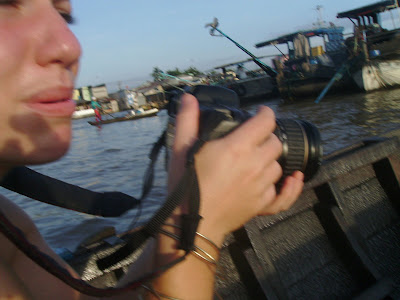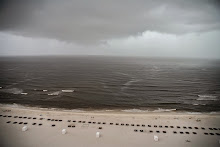
Sunrise on the Mekong. Worth waking up at 4:30 in the morning to experience the light on the water. Before we even saw the water, we were approached by a little old woman offering her boat for hire to visit the famous floating markets and cruise down the river. We spent 8 hours on the water, floating past the every day life of the people who live on the sprawling Delta.

Max.

People buying coconuts from the coconut boat.

Kara.

Between markets our enthusiastic boat driver pulled up to a small island and led us to a barn where they make rice noodles. She stopped along the way to pick flowers for us.

Kara shooting.

Rice soaks in water for several hours, turning it into a white paste.

Here the paste is spread over metal steamers.

The rice pancake is laid on racks of straw and bamboo to dry before being cut into rice noodles.

Another floating market.

The floating markets consist mostly of boats this size filled with various produce.

Typically the boats sell one item per boat. We stopped at the banana boat and the dragonfruit boat. We saw a duck boat next to us, selling live fowl by the kilo.

Kara looking dorky while steering the boat. Max doesn't endorse the use of the word "dorky" to describe Kara.

Really? Not dorky? Kara in between shots, getting her game face on.
The next day we took a bus to Chau Doc, a border town 2 kilometers from Cambodia. Upon arriving, we went up to Sam Mountain to get a better look at our new surroundings. Our motor bike got a flat on the way back.

Sam Mountain. Lots of locals come up here regularly to watch the sunset as well as tourists. Many pagodas can be found on this mountain as well. Although the tallest thing for miles, it is really more of a tall hill. It still gives a commanding view of the Mekong and we were able to see the border of Cambodia from here.

At the base of Sam Mountain is the international sculpture garden. It was also conveniently located across the street from our favorite vegetarian restaurant in town.
Last Day in Vietnam:

This road divides Cambodia and Vietnam. People lay their rice out to dry on the road. Everyone just drives over it. When in Rome....

Ducks. These were the cleanest ducks we saw all day.

Vietnamese countryside. Strikingly beautiful. Rice paddies for miles in more shades of green then we thought existed.

Rice piles. The straw is gathered around a central wooden pole and is stored outside in these piles.

Dirty ducks. We saw lots of these.
We had heard about the Khmer Rouge invasion of Vietnam and a monument to the victims in a nearby town. We searched for it for a long time without success. When a girl stopped us on the side of the street and asked if she could practice her English with Kara, we asked her if she knew of the "Khmer Rouge Skull Glass House" and she took us there.

Inside the small museum to the "Skull Glass House," we learned about the 1978 massacre of over 3,000 Vietnamese civilians by the Khmer Rouge. The killings happened over the course of two weeks. When we asked our new friend why this happened, she said she really didn't know. We really don't know either; we want to know more about this.

Graphic content.

"The Skull Glass House" is a monument that holds the skulls and bones of some of the people killed in the massacre.

They are arranged by age and gender, from under 2 years old to over 70.

Pagodas surround the monument. In one of them we found an altar to Ho Chi Minh. Kara says, "Yikes". Max thinks this is just as creepy as any other Ho Chi Minh personality worship.

More countryside.

We found this Buddha on top of an actual mountain late in the day. We had heard about it and had to pass through some bullshit authorities to get there. A motobike driver was trying to tell us that we needed to get off our motorbike so that he could drive us up there himself. He followed us a quarter up the mountain before realizing we weren't getting off and the real police didn't care if we were on our own.

This Buddha is massive. 30 meters tall to be exact. Birds fly through his nose and gigantic belly button.

Last look at the Cambodian border before crossing. Cambodia starts where the green rice paddies end and the water begins (right).
We learned a lot here and came to love this country. Its beautiful landscapes, relaxing beaches, historical significance and plentiful vegetarian food will be missed. Goodbye Vietnam.






































